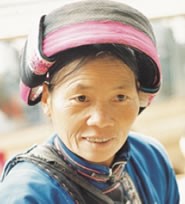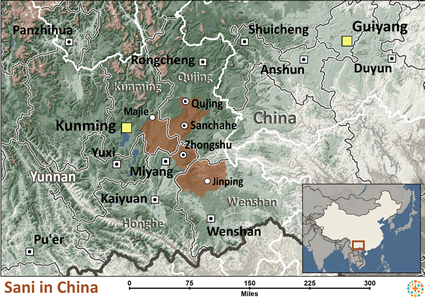Although they have been combined with numerous other people groups to form the large Yi nationality in China, the Sani possess their own unique language, customs, and ethnic identity.
The Sani are thought to have originated near Dali. Shortly after the Tang Dynasty (618-907) they left the region, traveled through Chuxiong, and settled among the rock formations of Shilin.
A single Sani girl's turban contains all the colors of the rainbow. This results from a Sani legend. A long time ago a beautiful Sani girl named Musidama was rescued from a tiger by a handsome hunter named Stiasai, and the two fell in love. The local chief lusted after her, however, and desired to marry her first. One day Stiasai was attacked by a wild boar and died. Musidama's heart was broken. At his funeral, she leaped into the flames before the chief's men could stop her. Only two small pieces of her clothing were torn off. "Soon two colorful clouds rose from the flames and then converged together. The sky cleared and a beautiful rainbow appeared. The Sani call it Saimusi-mudama to remember the lovers."
The Sani are polytheists. They believe the earth, sky, water, fire, mountains, stones, etc., have their own spirits. They also worship their ancestors.
Père Paul Vial of the Paris Foreign Missionary Society commenced work among the Sani in 1887. In the early 1900s he reported the Sani to be a haven of Catholicism with 7,360 converts and Sani priests ministering in 30 villages. Vial was a colorful figure, whose battles with Chinese officials led to attempted murder in 1894. Today there are Catholic believers in 22 of the 124 Sani villages in Shilin County. The 3,000 Sani Catholics in Shilin worship in seven main churches. In addition, a small number of Catholics are found among the Sani in Honghe Prefecture. Although there are only a relative handful of Protestants among the Sani, the Sani Catholics represent a great resource and hope for the salvation of many other Yi peoples in the area. Their persistence and faithfulness in the face of opposition have been a powerful witness.
The Sani must come to the Lord in order to receive true and everlasting rest.
Pray for the power of Christ to bind dark spiritual forces that prevent them from experiencing His presence.
Pray for them to see and believe the miracles of Jesus Christ and that this would spark a spiritual hunger in their hearts.
Pray for bold and loving workers who are driven by the love of the Holy Spirit to share Christ's love with the Sani.
Pray for the Sani to experience a mass movement to Christ soon.
Scripture Prayers for the Sani in China.
Operation China, Asia Harvest, Copyrighted © Used with permission.
| Profile Source: Joshua Project |

























